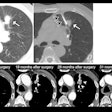Powering down idle interventional radiology (IR) imaging systems can substantially decrease carbon emissions and electricity costs, according to a group of researchers at University Hospital Basel in Switzerland.
The team estimated that annual energy consumption for seven imaging systems at their hospital was comparable to the energy use of 23 four-person households (115,684 kilowatt hours [kWh]) and that energy consumption during nonproductive work accounted for most of the total.
“Powering down idle-running interventional imaging systems outside of procedure times has substantial environmental sustainability benefits,” noted lead author Jan Vosshenrich, MD, and colleagues. The study was published March 20 in the American Journal of Roentgenology.
The healthcare industry’s global carbon footprint exceeds that of major economies like Germany, France, and the U.K., and collectively accounts for up to 8.5% of global CO2 emissions, the authors explained. Medical imaging constitutes the largest consumer within the sector, they noted.
With interest growing in reevaluating this energy consumption, the researchers equipped seven units at their hospital with power sensors: an interventional radiology suite, a neurointerventional suite, a radiology fluoroscopy unit, two cardiology laboratories, and two urology fluoroscopy units.
Power measurement logs were extracted for a single four-week period for each radiology and cardiology system and for a two-week period for each urology system. These were then analyzed based on being in “off,” “idle” (no patient in room), “active” (patient in room for procedure), and “net-imaging” (active fluoroscopic image acquisition) states.
According to projections, the systems had a combined total annual energy consumption of 115,684 kWh, which is comparable to the energy use of 23 four-person households, the group wrote. Also, nonproductive projected energy consumption accounted for 93% of the total, the team noted.
Next, a hypothetical operational adjustment whereby all systems would be switched from the idle to off state overnight and on weekends (versus operated in idle mode 24/7) revealed a potential annual savings in energy consumption of 144,640 kWh, carbon emissions of 18.6 million tonnes of carbon dioxide equivalent (MtCO2eq), and electricity costs of $37,896.
“Interventional imaging systems are energy intensive, with high consumption outside of image acquisition periods,” the authors wrote.
The researchers noted that practices may have concerns that repeated shutdowns and startups of interventional imaging systems may decrease their lifespan, void service warranties, or cause damages that require costly repair.
However, the practice of powering down interventional imaging systems on a daily basis at their hospital predated this study. And despite frequent system shutdowns and startups, the systems have not required any repairs since installation, they wrote.
“The present data close gaps in the existing literature with respect to such systems’ energy demands and may provide radiologists with an approach for modeling these systems’ energy consumption during optimization processes,” the group concluded.
The full study is available here.



















